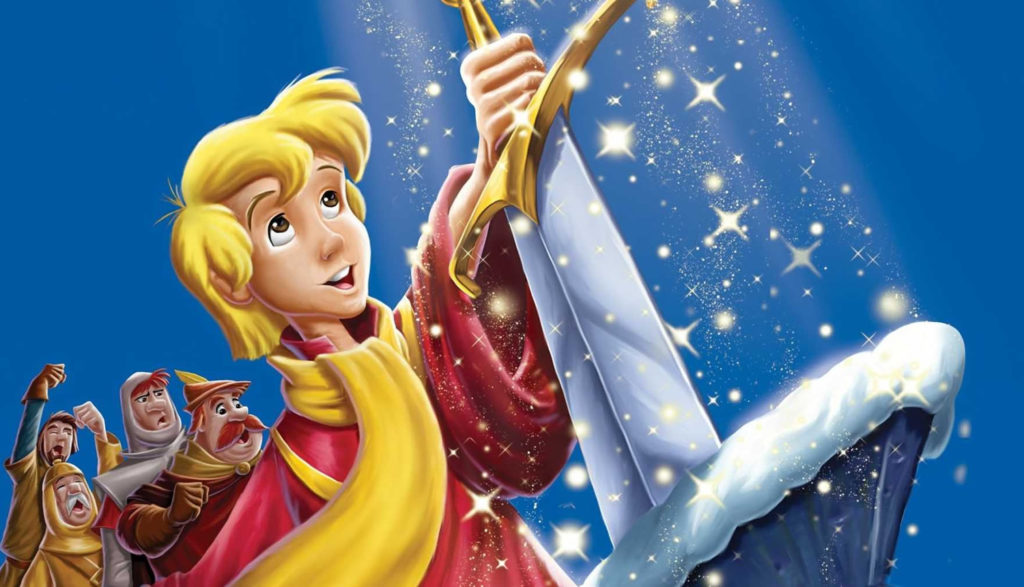
It was a dark age in England, without law or order. Men feared one another. The strong preyed on the weak. Years before, the good king had died without naming his heir. With no one to lead the country’s people, the land had descended into chaos.
Legend spoke of a sword bearing the promise that “whoso pulleth out this sword of this stone and anvil is rightwise king born in England.” Hundreds had tried to remove the weapon from its stony prison; but when none prevailed, it was soon forgotten.
That is, until Merlin appeared on the scene. Having spent some time traveling in the future, the wizard returns to the “big, medieval mess” to fulfill a prophecy (one that he foresaw himself) regarding the destiny of a young page called Wart.
Wart (whose real name is Arthur) is quite literally taken under the wing of Merlin and his companion, Archimedes, a talking owl. Together, Merlin and Archimedes teach the boy about the importance of knowledge and wisdom, hoping to prepare him for a future beyond just being the squire of his brutish older foster brother.
However, Wart can’t see himself accomplishing anything great. As an orphan, he’s been taught that serving a knight is about the highest honor he can ever hope to achieve. But Merlin perseveres in his duty to guide Wart, suspecting that he may well be the once and future king.
Wart is a sweet boy. Although his manners are a bit unrefined, he’s very polite. He shows loyalty and dedication, throwing himself wholeheartedly into every task he is given and never complaining. And when he is in the wrong, he accepts responsibility for his actions, admitting his mistakes and apologizing when he can.
Merlin recognizes Wart’s potential and teaches him about the inner qualities of a person, focusing on the importance of “brains” and not just “brawn.” He encourages Wart to trust his instincts and to push himself beyond what he thinks he is capable of. Merlin wants Wart to know what really matters in life, especially knowledge and wisdom; and the wizard risks his life several times over to instill those lessons in the child.
Archimedes and Merlin often appear at odds with one another, but there is a mutual respect born from decades of friendship. Archimedes is at first doubtful of Wart’s capabilities, but he saves Wart’s life on at least one occasion and stays behind to teach Wart even when Merlin abandons the cause.
Wart’s foster father, Sir Ector, is strict and often abrasive. However, he cares about the boy, scolding his own son, Kay, when he discovers that Kay allowed Wart to enter a dangerous forest on his own. He also later apologizes to Wart for his mistreatment. Kay, for his own part, treats Wart with disdain throughout the movie. But when he discovers Wart’s true potential, he softens and shows respect towards his younger foster brother.
Two knights speak up for Wart and allow him to prove his worth when Sir Ector refutes the boy’s claims.
Merlin identifies himself almost immediately as a wizard (or soothsayer or prognosticator, if you please). When asked if he partakes in black magic, Merlin denies it: “Never touch the stuff,” he exclaims, insisting that his magic is good and used for educational purposes.
Using a mixture of Latin phrases and gibberish, Merlin turns himself and Wart into a variety of creatures in the hope that the boy will learn a valuable life lesson from each animal he becomes. Merlin can also peer into the future, mildly affect the weather (he creates a miniature blizzard inside a castle), time-travel, make himself invisible and turn inanimate objects into sentient beings.
Although none of these things is inherently evil, he is called an “old devil” after frightening a cook by enchanting her dishes to wash themselves. However, even when he engages in a “wizard’s duel” with Madam Mim (a dark sorceress who does use black magic to wither flowers and to turn herself into a fire-breathing dragon), Merlin doesn’t use dark magic.
The sword in the stone magically appears in a churchyard out of a mystical, sparkly haze, illuminated by a light shining down from the heavens. When it is eventually pulled out by England’s rightful king, the light and sparkles return along with the voices of a heavenly choir.
People celebrate Christmas. Merlin’s home is filled with a cauldron, bubbling magical experiments and skulls. Wart is called a “little devil.” Someone uses the phrase “The devil take it!” twice, while someone else exclaims, “Heaven preserve us!”
While gallivanting around as squirrels (courtesy of Merlin’s magic) Wart and Merlin both catch the attention of female squirrels who hug and kiss them repeatedly.
After transforming herself into a voluptuous young maiden, Madam Mim shimmies her shoulders and wiggles her hips suggestively.
The violence that we see isn’t gory, but rather silly—especially since there’s never any lasting damage. During their wizard’s duel, Merlin and Madam Mim take turns transforming themselves into different animals, attempting to bite, crush and maim each other in different ways. A wolf eagerly trying to catch its next meal winds up getting accidentally hit with tree branches, falling down cliffs and even bitten by a squirrel.
There are a few perilous moments, such as when Wart (transformed into a fish by Merlin’s magic) is attacked by a pike with sharp teeth in the castle’s moat. Archimedes manages to pull Wart from the water, but not before he, Wart and Merlin get knocked around and bitten by the pike a few times as well.
Knights armed with swords and spears joust and spar, sometimes knocking one another down or damaging each other’s armor. Two knights are beaten up by enchanted dishes and mops, and Kay is thrown over a castle wall during a failed jousting practice.
Kay tries to hit Wart with a stick several times. A man shoots an arrow at a deer (but misses). A hawk dives for a squirrel and later a small bird, narrowly missing its prey both times. When Wart is a fish, he eats a live bug.
Although there is no profanity, people use exclamations such as “blast it all,” “gadzooks” and “Jehoshaphat!” “Shut up” is heard once. And there are also a few mild insults, including “blockhead,” “fool” and “dummy.” Someone says, “For heaven’s sake,” and another person shouts, “Good heavens!”
A few men drink wine and make toasts at mealtimes. Merlin smokes from a pipe a few times and blows smoke into Archimedes face in one instance.
The forest where we first find Merlin (and later Madam Mim) is dark and creepy. We see a silhouetted wolf with red eyes there, and Wart is later warned that he’ll never return if he enters the forest. The pike that tries to eat him is also quite menacing.
Madam Mim describes herself as “mad” and proudly proclaims that she “delights in the gruesome and grim.” Because of this, she despises Merlin, who represents everything that is good. She lies, cheats and even tries to destroy Wart because of his association with Merlin.
Merlin can be a bit brunt with people when things don’t go his way. He openly mocks Wart’s foster family, and when Wart is made into a squire, he scoffs at the boy and stomps around in a huff, disappointed that Wart would settle for “mediocrity.”
When Merlin uses magic to complete Wart’s chores for him, Wart tries to point out that he’s supposed to do the work himself, since it’s part of his punishment. But Merlin declares that as long as the work gets done, it doesn’t matter who did it. Eager to spend more time with the wizard, Wart accepts Merlin’s terms—though he is later disciplined when Sir Ector finds out.
Sir Ector gives Merlin the “best room” in the castle, which turns out to be a rickety old tower with a leaky roof. Characters eavesdrop, threaten, taunt and bully one another.
The story of King Arthur and his Knights of the Round Table is a well-known fable. But this iteration, based on the novel by T.H. White, gives us a glimpse at what the legendary king was like before he pulled the sword from the stone.
Wart is a good kid. Sure, he messes up from time to time (what kid doesn’t?); but he respects his elders and dutifully goes about his tasks, keen to please and excel. He cares deeply for all beings—as proven by his horror when he eats a bug and his guilt when he hurts the feelings of a squirrel—and eagerly accepts every new bit of information that Merlin gives to him.
Wart also stands up for what he believes is right, defending Merlin when Sir Ector expels the wizard from the castle for using magic. “Just because you don’t understand doesn’t mean it’s wrong!” Wart passionately exclaims.
But that brings up a point of contention for Sir Ector. The lines between sorcery and the supernatural can get quite fuzzy in this film. There’s Merlin, who uses “good” magic, Mim, who uses “dark” magic, and then there’s the sword itself, which is described as a “miracle ordained by heaven.” It’s no wonder the poor man can’t figure out what’s acceptable and what isn’t. And although God is never mentioned, Merlin’s use of magic to steer Wart towards his destiny almost suggests that he has received some sort of stamp of approval from heaven.
It should also be noted that as far as Disney’s dark sorceresses go, Mim is more comical than frightening in nature. In fact, I’d reckon that the pike and hawk that attempt to eat Wart are far more intimidating than the mad little witch.
So although The Sword in the Stone certainly delves into the world of magic and sorcery, it’s meant to be light and fun. In fact, the most important lesson that Wart learns is that at all costs, he should try to use his head to find solutions before resorting to simpler (but cruder) means such as violence and magic.


Emily studied film and writing when she was in college. And when she isn’t being way too competitive while playing board games, she enjoys food, sleep, and geeking out with her husband indulging in their “nerdoms,” which is the collective fan cultures of everything they love, such as Star Wars, Star Trek, Stargate and Lord of the Rings.